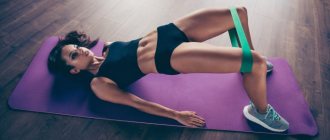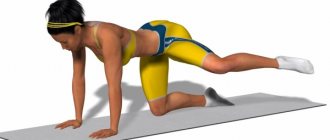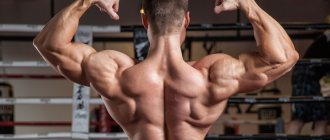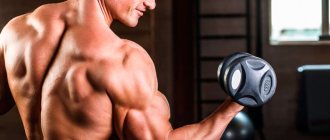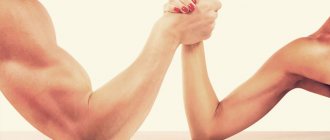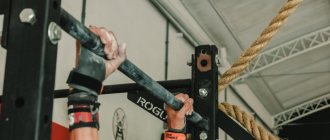Weight training and other types of exercise that help strengthen the muscles of the buttocks, thighs and legs will help pump up your legs while doing fitness and sports in order to lose weight and build muscle mass. If desired, you can perform them at home. In a month, the first results will be noticeable.
To achieve weight loss and pump up your legs, a man should pay attention to problem areas in each workout and carefully work on them.
- Lateral, or to the side
- Regular
- "Gluteal Bridge"
Muscles that need to be worked
Before starting classes, it is necessary to determine those areas that need to be pumped up in order to obtain a beautiful and correct shape. Usually pay attention to the following areas of the lower extremities:
- the inner side of the thigh, where it is quite difficult to pump muscles;
- the front surface of the thigh, which gives the correct shape to the legs;
- back of the thigh;
- gluteal muscles;
- calves, or shins, which are not so difficult to pump up.
One of the important muscles for the formation of a beautiful relief of the muscles on the front surface of the thigh is the quadriceps (quadriceps). It is responsible for flexion and extension of the leg at the knee joint and forms the patella region. If this muscle is weak and untrained, leg shape and strength will deteriorate.
What should you do to pump up your legs at home?
Leg exercises at home are suitable for athletes of any level of training. They can be done either with weights or using your own weight. The number of sets and reps varies depending on your form.
It is necessary to pump your legs at home in such a way that the load is evenly distributed over all the muscles. Exercises for your calves will not work for your thighs and vice versa. In each session, try to include all muscles in the work.
General recommendations
Simple rules that must be followed by beginners and advanced athlete will help increase the effectiveness of home training:
- Moderation. It is the main condition for the effectiveness and safety of training. You shouldn’t load your body with heavy exercises and loads on the first day, especially if the guy or man has never trained before that day. This will lead to injury or strain to the muscles and ligaments.
- Regularity. There will be no benefit from training once a month, and the muscles from such a rare load will not grow and will become very sore. The optimal training regimen is 3 sessions per week lasting 1.5-2 hours for advanced athletes and 30-60 minutes for beginners. It is important to listen to your body and stop when your strength is running low. Excessive exercise will not lead to the desired result, but can harm the body.
- The need to warm up before each lesson. It will prepare the muscles for the upcoming loads and prevent injury. For warming up, you should choose simple rhythmic exercises that will allow you to get ready for further training.
- The need for a cool down. The session should end with some kind of muscle stretching exercise.
Beginners are not recommended to start with heavy loads and use weights of more than 3 kg each. For experienced athletes, the weight of each dumbbell can reach 10-15 kg.
For training, you should choose a spacious room, ventilate it, wear comfortable sportswear and take weights in accordance with your level of physical fitness.
How long should a leg workout last?
If you work out using a split system and work out two muscle groups in one day (for example, legs + shoulders), then the class should last no more than an hour. Training always releases cortisol and other catabolic hormones responsible for the destruction of muscle fibers. If you delay the time of their release, then recovery from such stress will greatly slow down due to the slowdown in the release of anabolic hormones, including testosterone.
You need to rest for 60-90 seconds between sets. Why is that? It's simple: this mode will allow you to do much more work in a training session than if you rested three minutes between sets. This is exactly the essence of bodybuilding when compared to powerlifting. Muscles grow better from volume work with medium weights, and strength, on the contrary, grows from low-volume work with heavy weights. If you don’t have enough time to recover, you can rest longer.
Warm-up
It is recommended to perform simple exercises:
- Jumping rope for 5-7 minutes. You can choose the pace yourself. You should not jump quickly; it is important to feel the warming up of each muscle at a moderate pace. You are allowed to jump on two legs or alternately, it doesn’t matter.
- Swing your legs forward . They must be performed in a standing position, raising straight legs one at a time to chest level for 2-3 minutes. Keep the rhythm moderate.
A similar warm-up for 10 minutes will help warm up your muscles and prepare for the upcoming loads. Instead of jumping rope, you can run in place or quickly walk around the room. This option is suitable for beginners and those who begin classes after severe injuries to the musculoskeletal system.
Dumbbell workout
Exercises with dumbbells will be the first step for those who want to build up their legs. They are effective, bring quick results, and the weight of the weights can be chosen taking into account the degree of preparedness. This allows them to be used for training beginners and professionals.
The following exercises will be the most effective and easiest to perform.
Jumping
They help pump up all the thigh muscles.
Exercise technique:
- Take the starting position - standing with your feet shoulder-width apart.
- Take a dumbbell in each hand.
- Squat with them and jump as high as possible.
- Repeat 10 times.
For advanced athletes, the number of repetitions increases to 25 times. The weight of each dumbbell for a beginner is from 1 to 2 kg, for a professional - up to 5 kg.
Holding on one leg
You will also need a dumbbell for this exercise. It helps strengthen and pump up the front muscles of the thigh, lower leg and buttocks.
Technique:
- Take the starting position - standing, holding your hands on a wall or chair.
- Place a round dumbbell on the toes of one foot.
- Raise your leg 10 cm from the floor.
- Hold for at least 20 seconds.
- Repeat for the second leg.
For each leg you need to do at least 3 approaches.
The weight of the weight for a beginner should not exceed 2 kg, for professionals 4-5 kg is allowed. For those who want to complicate the execution, they are allowed not to hold on with their hands, but to try to maintain balance without support.
How to pump up calves at home
Almost all calf exercises can be performed without additional weights. As you progress, you will need to complicate the process by adding weights. This will help speed up muscle growth.
You can pump up your calves at home using the following leg exercises:
- Take the starting position: rest your hands on a wall or other support. Slowly stand on your toes, pausing for a couple of seconds when you reach the top point. Lower yourself to the starting position, placing your foot completely on the floor. To add efficiency, you can do the exercise separately for each leg.
- One approach should contain from 25 to 40 repetitions. In total you need to do 4-5 approaches.
- If you are not a beginner, use dumbbells. Before pumping up your calves at home, get this equipment. Don't have dumbbells on hand? It doesn’t matter, they can be replaced with plastic bottles that hold water or sand.
- To avoid losing your balance, hold onto any stable object with one hand and support additional weight with the other.
How to pump up your calf muscles at home using improvised means? Very simple. To do this, we only need a step or a couple of thick books:
- Take a weight in your hands (dumbbells will do; if you don’t have them, then regular water bottles). Stand on books or a step with your heels hanging in the air. While maintaining your balance, perform calf raises.
- Leg exercises at home can be made more difficult by placing your toes apart. This will shift the emphasis of the load to the inner surface of the calf muscles. After doing one set this way, bring your toes together and do a set this way.
Calf exercises
Simple walking on your toes will also help to pump up your legs at home. It is not for nothing that it has been used by ballerinas for centuries to make their legs slender and strong. Speaking of ballerinas, we have a separate article: how to pump up girls’ calves at home. So, at first glance, this exercise may seem trivial, but try walking for 30 minutes on your toes with weights to feel how your muscles burn from the exertion.
Let's talk about how to pump up your calves at home using a staircase in the entrance. Choose a time when she will be more or less free from people. For 30 minutes, simply walk up the stairs, trying to feel the work of your calf muscles as you go up.
Exercises for calves at home can be performed using a simple jump rope. Boxers use this item to develop endurance and pump up their legs, so why not follow their example. This way you will get not only developed calves, but also voluminous lungs. You can also jump with dumbbells. This will increase the load even more.
The next exercise is performed with a weight placed on your knees. You can use them to carry a backpack with books or a bottle of water. Sit on a chair with the chosen object on your lap. Slowly raise your feet onto your toes, feeling your calves work. The extra weight is ideal if after 20 repetitions the lice muscles are literally burning.
For experienced athletes who do not have problems with balance, leg exercises at home can be varied with one-leg squats. Not everything may go smoothly at first, but over time you will appreciate the effect.
By doing these simple exercises you can get the calves of your dreams. But to pump up a man’s legs at home, you should pay attention to other muscles.
Lunges
Lunges will be the most effective exercise for the muscles of the buttocks and thighs, will help to form a beautiful relief and eliminate fat in these areas. Suitable for beginners and advanced athletes.
There are several ways to perform lunges that are equally effective for targeting problem areas.
Lateral, or to the side
This is the simplest option to work on problem areas of the legs.
Technique:
- Take the starting position - standing on the floor with your legs previously spread, shoulder-width apart.
- Lunge with one leg to the side. The second leg should be straightened and the foot should be on the floor.
- Hold the position for 10 seconds.
For each leg you need to perform 3 approaches.
Beginners should not use weights; professionals are allowed to take dumbbells weighing up to 5 kg in each hand.
Bulgarian
This version of lunges is performed with minor complications.
Technique:
- Take a standing position on the floor with your feet shoulder-width apart. A chair or bench should be placed at the back.
- Place one leg on the bench, pre-bent at the knee.
- Lunge on the other leg.
For each leg, repeat the exercise at least 10 times for beginners. Advanced athletes are allowed to use weights up to 4 kg in each hand and do at least 20 repetitions for each limb.
Low
This version of lunges is performed forward and allows you to pump the quadriceps of each leg, buttocks, and lower legs.
Technique:
- Take a standing position on the floor with your feet shoulder-width apart.
- Lunge forward with one limb so that the knee of the other touches the floor.
- For each leg, perform 10 times.
Beginners are advised to place their hands on their sides when performing the exercise. Trained men should take a weighting device weighing up to 4 kg in each hand.
Cross
This is a complicated version of lunges that allows you to pump all the muscles of the thighs, legs and buttocks.
Technique:
- Take the starting position - standing on the floor with your legs apart, shoulder-width apart.
- Lunge forward so that both limbs form one line.
For each leg you should do at least 10 repetitions. Beginners should not use weights, as it is quite difficult to maintain balance when performing lunges. Trained people are allowed to take a dumbbell in each hand. The weight of each should not exceed 2-3 kg.
Massive leg training program
The complex consists of basic and isolating exercises:
- Squats with a barbell on the shoulders - 2 x 30 reps for warm-up + 3 x 20 sets with working weight) – pumps up the quadriceps;
- Bench leg press (3 x 20, gradually increase the weight on the machine) - pumps the front of the thigh
- Deadlift (2 x15-20 for warming up with light weights + 3 x 15-20 with working weight) – we work the back of the legs – the hamstrings;
Insulating:
- Leg extensions in the simulator (3-4 sets of 15 repetitions with a gradual increase in weights on the simulator) – isolated pumping up the quadriceps;
- Leg curls in the simulator (3-4 X 15) – we train the thigh biceps;
- Standing calf raises (2-3 sets x 15-20 repetitions) – pumping the calf muscles;
- Seated calf raises (2-3 x 15-20) – we pump up the soleus muscles (those located under the calf muscles).
Squats
Squats are considered the most effective exercise for working the muscles of the lower extremities, buttocks and building muscle mass in these areas. It is for this reason that every training program should have it.
The following types of squats are considered the most effective for pumping up your legs.
Regular
This is a simple and effective exercise for pumping up muscle mass not only in the legs, but also in the buttocks area.
Technique:
- Take the starting position - standing on the floor with your feet shoulder-width apart. Place your arms freely at your sides or extend them forward.
- Squat without lifting your heels from the floor, without rounding your back, without lowering your head.
Completion time for beginners is 1 minute, for trained ones - up to 3 minutes at a moderate pace.
On one leg
This option is more suitable for professionals, as it requires increased concentration and the ability to accurately maintain balance.
Technique:
- Take a starting position similar to the previous exercise.
- Raise one pre-straightened leg parallel to the floor.
- On the other, do squats.
Do 20 repetitions for each leg. A beginner should start with 5 repetitions, gradually increasing this number.
With weights
The exercise is suitable for trained men and those who are just starting to exercise. It is performed similarly to regular squats, but a dumbbell is taken in each hand during the execution.
Weight for experienced athletes is from 3 to 6 kg, for beginners 1-2 kg is enough.
You should start with 10 repetitions, gradually increasing this number to 20-30 times per workout. Weight also needs to be increased gradually, especially for untrained people and young guys.
Shifting weight forward
The exercise is performed similarly to the previous one. The difference is that the hands with dumbbells should be held as close to the chest as possible so that all their weight falls on the shoulders and arms. This will create additional tension in the buttocks, thighs and legs, which will be involved in maintaining the balance of the whole body.
You should do up to 20 squats. The weight of weights for beginner athletes should not exceed 3 kg; for professionals, up to 5 kg in each hand is allowed.
What exercises to do for the front of the thigh
Here are the quadriceps, the large muscles of four heads. The quadriceps extends the lower leg, and its central head, the rectus femoris, also flexes the thigh.
Back Squats
The exercise uses the muscles of the legs and core, and puts a good load on the front of the thigh.
Take the barbell from the racks, squeeze your shoulder blades together, straighten your chest, straighten your back. Place your feet shoulder-width apart and turn your toes slightly to the sides. Move your pelvis back and squat until your thighs are parallel to the floor. During this process, do not lift your heels off the floor and do not lie with your stomach on your knees.
As you come out of the squat, don't bring your knees together. Look straight ahead and concentrate on working your muscles.
Front Squats
Effectively pumps A biomechanical comparison of back and front squats in trained healthy individuals the front side of the thigh, especially the inner Kinematic and EMG activities during front and back squat variations in maximum loads part (medial head). Such squats are safer for the knees and lower back than the version with weight on the back.
Remove the bar from the racks, bring your elbows forward, arch your back. Place your feet shoulder-width apart and turn your toes slightly to the sides. Squat until your thighs are parallel to the floor or slightly lower and rise back up.
Lunges
Well loaded HAMSTRINGS, QUADRICEPS, AND GLUTEAL MUSCLE ACTIVATION DURING RESISTANCE TRAINING EXERCISES, Muscle activity during leg strengthening exercise using free weights and elastic resistance: Effects of ballistic vs controlled contractions the entire front surface of the thigh.
If you have trouble keeping your balance in this exercise, try backward lunges: they are easier, but less effective. Comparative Analysis of Lunge Techniques: Forward, Reverse, Walking Lunge.
You can do lunges with different weights: with a barbell on your shoulders, with dumbbells in your hands, with an expander band. To begin with, it is better to try dumbbells: it will be easier to maintain balance.
Stand up straight, take weights in your hands, straighten your shoulders, straighten your back. Lunge forward, do not touch the floor with the knee of your back leg: leave a space of 5-10 centimeters between them. Straighten up and repeat on the other leg.
Some people do lunges while walking around the gym. If your goal is to burn more calories and strengthen your core muscles, they can be helpful. But they pump up the hips worse than Comparative Analysis of Lunge Techniques: Forward, Reverse, Walking Lunge than forward lunges in place.
Leg press in the gym
Same as squats, but with minimal stress on the core muscles and back extensors. Due to this, you can take more weight without risking breaking your back, and better load your hips. In addition, the leg press pumps up the front of the thigh just as effectively Quadriceps EMG/force relationship in knee extension and leg press as the leg extension in the simulator, but does not load the knees as much.
Sit on the exercise chair, press your lower back to the back and do not lift it until the end of the exercise. Place your feet at the bottom of the platform: this position maximally loads the Analysis of Muscle Activation During Different Leg Press Exercises at Submaximum Effort Levels on the front of the thigh. High stance of the legs provides more load on the buttocks.
Under the weight of the platform, bend your legs to a right angle at the knees, and then press it back. At the extreme point, do not straighten your knees completely, leave them slightly bent.
Cardio exercises
Cardio exercises are an addition to the main training complex. Running is considered the most effective form of exercise. It trains the muscles of the legs and buttocks, eliminates excess fat in this area and builds muscle mass.
The optimal time for a beginner is 20 minutes at a moderate pace. A trained person can increase this period to 1 hour. The frequency of training is 2-3 times a week. If it is not possible to run outdoors, it is allowed to replace the session with training in the gym on a treadmill or on an orbit track.
Combining such activities with weight training exercises will allow you to achieve noticeable results in a short time.
